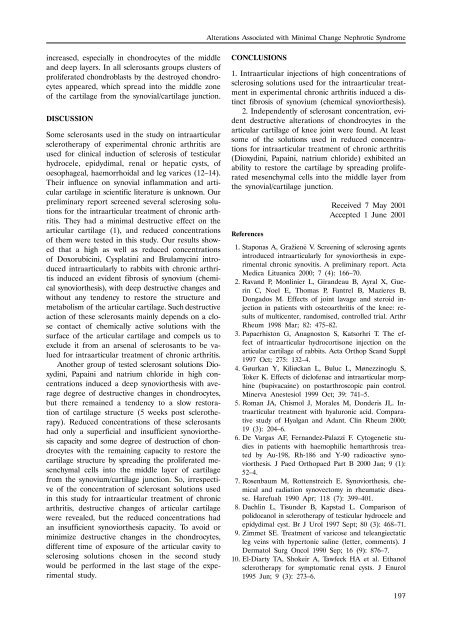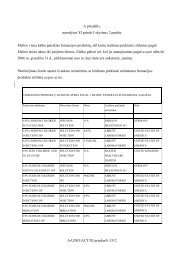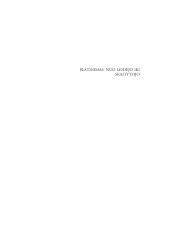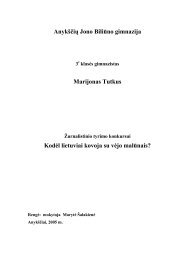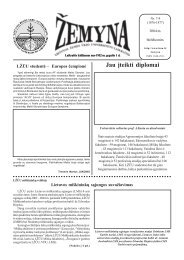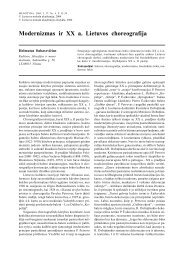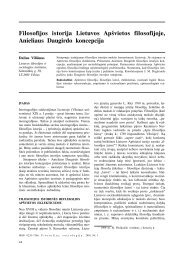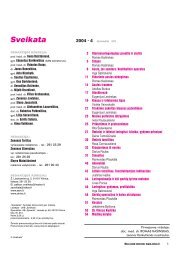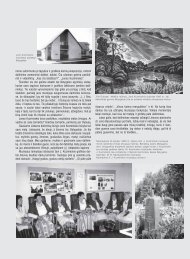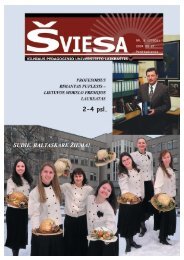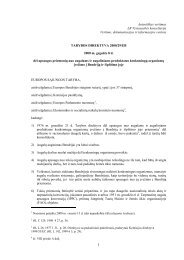Screening of Sclerosing Agents Introduced Intraarticularly for ...
Screening of Sclerosing Agents Introduced Intraarticularly for ...
Screening of Sclerosing Agents Introduced Intraarticularly for ...
Create successful ePaper yourself
Turn your PDF publications into a flip-book with our unique Google optimized e-Paper software.
increased, especially in chondrocytes <strong>of</strong> the middle<br />
and deep layers. In all sclerosants groups clusters <strong>of</strong><br />
proliferated chondroblasts by the destroyed chondrocytes<br />
appeared, which spread into the middle zone<br />
<strong>of</strong> the cartilage from the synovial/cartilage junction.<br />
DISCUSSION<br />
Some sclerosants used in the study on intraarticular<br />
sclerotherapy <strong>of</strong> experimental chronic arthritis are<br />
used <strong>for</strong> clinical induction <strong>of</strong> sclerosis <strong>of</strong> testicular<br />
hydrocele, epidydimal, renal or hepatic cysts, <strong>of</strong><br />
oesophageal, haemorrhoidal and leg varices (12–14).<br />
Their influence on synovial inflammation and articular<br />
cartilage in scientific literature is unknown. Our<br />
preliminary report screened several sclerosing solutions<br />
<strong>for</strong> the intraarticular treatment <strong>of</strong> chronic arthritis.<br />
They had a minimal destructive effect on the<br />
articular cartilage (1), and reduced concentrations<br />
<strong>of</strong> them were tested in this study. Our results showed<br />
that a high as well as reduced concentrations<br />
<strong>of</strong> Doxorubicini, Cysplatini and Brulamycini introduced<br />
intraarticularly to rabbits with chronic arthritis<br />
induced an evident fibrosis <strong>of</strong> synovium (chemical<br />
synoviorthesis), with deep destructive changes and<br />
without any tendency to restore the structure and<br />
metabolism <strong>of</strong> the articular cartilage. Such destructive<br />
action <strong>of</strong> these sclerosants mainly depends on a close<br />
contact <strong>of</strong> chemically active solutions with the<br />
surface <strong>of</strong> the articular cartilage and compels us to<br />
exclude it from an arsenal <strong>of</strong> sclerosants to be valued<br />
<strong>for</strong> intraarticular treatment <strong>of</strong> chronic arthritis.<br />
Another group <strong>of</strong> tested sclerosant solutions Dioxydini,<br />
Papaini and natrium chloride in high concentrations<br />
induced a deep synoviorthesis with average<br />
degree <strong>of</strong> destructive changes in chondrocytes,<br />
but there remained a tendency to a slow restoration<br />
<strong>of</strong> cartilage structure (5 weeks post sclerotherapy).<br />
Reduced concentrations <strong>of</strong> these sclerosants<br />
had only a superficial and insufficient synoviorthesis<br />
capacity and some degree <strong>of</strong> destruction <strong>of</strong> chondrocytes<br />
with the remaining capacity to restore the<br />
cartilage structure by spreading the proliferated mesenchymal<br />
cells into the middle layer <strong>of</strong> cartilage<br />
from the synovium/cartilage junction. So, irrespective<br />
<strong>of</strong> the concentration <strong>of</strong> sclerosant solutions used<br />
in this study <strong>for</strong> intraarticular treatment <strong>of</strong> chronic<br />
arthritis, destructive changes <strong>of</strong> articular cartilage<br />
were revealed, but the reduced concentrations had<br />
an insufficient synoviorthesis capacity. To avoid or<br />
minimize destructive changes in the chondrocytes,<br />
different time <strong>of</strong> exposure <strong>of</strong> the articular cavity to<br />
sclerosing solutions chosen in the second study<br />
would be per<strong>for</strong>med in the last stage <strong>of</strong> the experimental<br />
study.<br />
Alterations Associated with Minimal Change Nephrotic Syndrome<br />
CONCLUSIONS<br />
1. Intraarticular injections <strong>of</strong> high concentrations <strong>of</strong><br />
sclerosing solutions used <strong>for</strong> the intraarticular treatment<br />
in experimental chronic arthritis induced a distinct<br />
fibrosis <strong>of</strong> synovium (chemical synoviorthesis).<br />
2. Independently <strong>of</strong> sclerosant concentration, evident<br />
destructive alterations <strong>of</strong> chondrocytes in the<br />
articular cartilage <strong>of</strong> knee joint were found. At least<br />
some <strong>of</strong> the solutions used in reduced concentrations<br />
<strong>for</strong> intraarticular treatment <strong>of</strong> chronic arthritis<br />
(Dioxydini, Papaini, natrium chloride) exhibited an<br />
ability to restore the cartilage by spreading proliferated<br />
mesenchymal cells into the middle layer from<br />
the synovial/cartilage junction.<br />
References<br />
Received 7 May 2001<br />
Accepted 1 June 2001<br />
1.Staponas A, Graþienë V. <strong>Screening</strong> <strong>of</strong> sclerosing agents<br />
introduced intraarticularly <strong>for</strong> synoviorthesis in experimental<br />
chronic synovitis. A preliminary report. Acta<br />
Medica Lituanica 2000; 7 (4): 166–70.<br />
2.Ravand P, Monlinier L, Girandeau B, Ayral X, Guerin<br />
C, Noel E, Thomas P, Fantrel B, Mazieres B,<br />
Dongados M. Effects <strong>of</strong> joint lavage and steroid injection<br />
in patients with osteoarthritis <strong>of</strong> the knee: results<br />
<strong>of</strong> multicenter, randomised, controlled trial. Arthr<br />
Rheum 1998 Mar; 82: 475–82.<br />
3.Papacrhiston G, Anagnoston S, Katsorhri T. The effect<br />
<strong>of</strong> intraarticular hydrocortisone injection on the<br />
articular cartilage <strong>of</strong> rabbits. Acta Orthop Scand Suppl<br />
1997 Oct; 275: 132–4.<br />
4.G^urkan Y, Kili^ckan L, Buluc L, M^nezzinoglu S,<br />
Toker K. Effects <strong>of</strong> dicl<strong>of</strong>enac and intraarticular morphine<br />
(bupivacaine) on postarthroscopic pain control.<br />
Minerva Anestesiol 1999 Oct; 39: 741–5.<br />
5.Roman JA, Chismol J, Morales M, Donderis JL. Intraarticular<br />
treatment with hyaluronic acid. Comparative<br />
study <strong>of</strong> Hyalgan and Adant. Clin Rheum 2000;<br />
19 (3): 204–6.<br />
6.De Vargas AF, Fernandez-Palazzi F. Cytogenetic studies<br />
in patients with haemophilic hemarthrosis treated<br />
by Au-198, Rh-186 and Y-90 radioactive synoviorthesis.<br />
J Paed Orthopaed Part B 2000 Jan; 9 (1):<br />
52–4.<br />
7.Rosenbaum M, Rottenstreich E. Synoviorthesis, chemical<br />
and radiation synovectomy in rheumatic disease.<br />
Harefuah 1990 Apr; 118 (7): 399–401.<br />
8.Dachlin L, Tisunder B, Kapstad L. Comparison <strong>of</strong><br />
polidocanol in sclerotherapy <strong>of</strong> testicular hydrocele and<br />
epidydimal cyst. Br J Urol 1997 Sept; 80 (3): 468–71.<br />
9.Zimmet SE. Treatment <strong>of</strong> varicose and teleangiectatic<br />
leg veins with hypertonic saline (letter, comments). J<br />
Dermatol Surg Oncol 1990 Sep; 16 (9): 876–7.<br />
10.El-Diarty TA, Shokeir A, Tawfeck HA et al. Ethanol<br />
sclerotherapy <strong>for</strong> symptomatic renal cysts. J Enurol<br />
1995 Jun; 9 (3): 273–6.<br />
197


